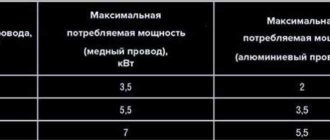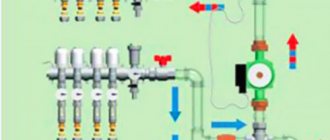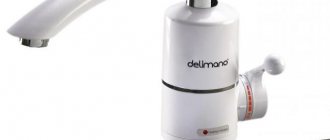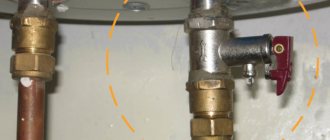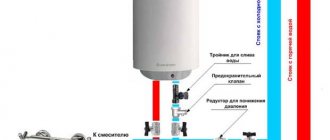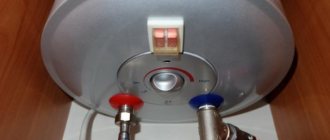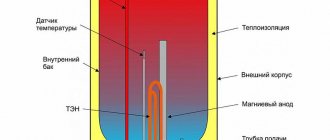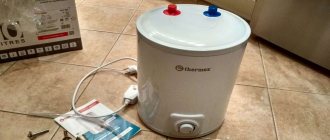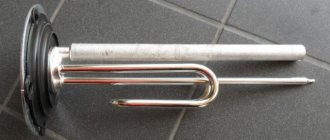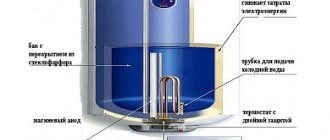What is an induction water heater
Induction water heater design
Children study the phenomenon of induction at school during physics lessons, but rarely does anyone think about the practical application of information from textbooks. The peculiarity of an induction coil is its ability to generate induced currents, which heat up the matter inside the coil.
This heating was first used in industry: it is used to melt metal. And then the principle of induction migrated to household appliances. It all started with induction hobs and now induction water heaters have appeared.
The design of such devices is extremely simple: a pipe made of non-ferrous metals with good thermal conductivity, copper wire is wound around it and all this is connected to an inverter, which converts the current from the network into a high-frequency current with a frequency of 2 to 5 MHz.
A high frequency current passes through the coil, and it generates an alternating magnetic field, inside which a pipe with water appears. This is how heating occurs.
The induction water heater is connected to both the hot water supply and the heating circuit.
Features of devices
Using such a device at home allows you to get maximum performance and operational reliability. In this case, the unit does not need to be accompanied by special documentation and permission for installation, for example, as a gas boiler. By using an induction heater as a traditional heating boiler, in some cases the use of a pump will not be required. The movement of the coolant is achieved through convection processes: when heated, water turns into steam.
It is worth noting that an induction water heater has many advantages that set it apart from its competitors.
- The cost of such a device is insignificant.
- It is possible to assemble the heater yourself.
- Doesn't make any extraneous noise. The coil vibrates quite strongly during operation, but it is practically not noticeable.
- Due to constant vibration, dirt and scale do not have time to attach to the functional elements, so the device does not need regular cleaning.
- It contains a heat generator, which is very easily sealed. Water, acting as a coolant, is placed in a heating element, due to which energy is transmitted through a magnetic field. It does not require the use of contacts, and therefore oil seals and various rubber seals, which tend to quickly fail.
- It rarely breaks, since a simple tube is responsible for heating the water, in which there is simply nothing to break or burn out.
By choosing an induction water heater, the owner receives a device with minimal maintenance, since it consists of a small number of components. And they, in turn, very rarely fail.
Operating principle of an induction boiler
But you can’t do without shortcomings. As with any type of technology, they exist.
- High electricity consumption, which will result in high electricity bills;
- The device gets very hot, and everything around it becomes hot, so you should not touch the device while it is operating.
- An induction water heater has strong heat transfer, so it is necessary to install a temperature sensor to prevent overheating of the device, and, accordingly, an explosion.
Advantages and disadvantages of the device
Induction water heating device
A person compares new technologies with what is already familiar and familiar to him. In this case, an involuntary comparison occurs with water heaters using heating elements. And here the induction boiler outperforms its older brother in a number of parameters:
- Simplicity of design: there is nothing in it to break or fail.
- Tightness: unlike the TEN, which must be placed inside a container with water, the heating element in induction devices is placed outside, leaving the water pipe sealed.
- Uniform heating: the heating element heats the water in its immediate vicinity, it rises upward, displacing cold water down, which also gradually heats up.
- High efficiency: for an induction heater it reaches 98%, which means that only 2% of the energy expended is wasted. Thanks to this, the device provides more power with less energy consumption.
- Cost-effective: such devices allow you to save up to 30-35% on electricity.
- Compactness: small sizes, so surprising at first glance, will be a real salvation in a small bathroom, where space is already limited.
- Reliability: inverter water heaters last a long time, up to 30 years. This is also facilitated by the simplicity of the design. After all, it is known that the simpler the device, the more reliable it is.
- Easy to maintain: such a heater will need preventative cleaning once every 10 years, because scale will not form inside it. Alternating currents do not allow numerous salts dissolved in water to settle on the inner surface of the pipe. And on the outside, where all the parts of the mechanism are located, there is no water.
The list of advantages is impressive. At the same time, only one drawback can be identified, although for many it will be significant. The fact is that, like any new development, induction heaters are still very expensive.
Recommendations for installing an induction heater
When making a water heater with your own hands, it is important to follow the sanitary standards and rules that are established for this type of construction.
Let's consider the basic requirements that should be taken into account during the installation of induction devices
- It is unacceptable to install closed communications. In this case, forced circulation of the coolant should be ensured using a special pump.
- The distance between the induction device and the wall surface must be at least 30 cm . The distance from the surface of the device to the ceiling of the room must also be maintained, about 80 cm.
- It is acceptable to include an induction design in a heating system that is equipped with a plastic pipeline .
- , an automatic air venting mechanism , a pressure gauge and a blast valve should be built in after the outlet pipe of the device .
How to choose an induction boiler
Induction heating boiler
When choosing an induction instantaneous water heater, you need to pay attention to the following characteristics:
- power consumption;
- thermal power;
- the volume of the room that it can heat;
- required network voltage.
It also makes sense to pay attention to the manufacturer. Perhaps the most popular are the products of several companies:
- VIN;
- SAV;
- Geyser;
- Miratron;
- Edison.
All these manufacturers are highly reliable and have a large selection of models.
Popular heater models
Vortex induction heater VIN 7
One of the most popular and sought-after models is the VIN 7 water heater. Its power is 7 kW, which is reflected in the name of the model. Operates from a network of 200 V, frequency - 50 Hz, capable of producing up to 5900 kcal/hour. This is enough to heat a room with a volume of up to 340 cubic meters.
Another undeniable advantage of this model is its compactness. The heater is a cylinder with a height of 620 mm and a diameter of 133 mm. At the same time, it can produce a large pressure of water. The cost varies from 43 to 45 thousand rubles.
Another popular option in the same price range is Edison 4.7. Its power is 4.7 kW and at the same time it produces heat of 3960 kcal/hour. With its help you can warm up a room measuring 240 cubic meters.
Since the industry is evolving so quickly, be sure to consult with a professional before purchasing. It is quite possible that new, more interesting models will be released onto the market by this time.
If you haven’t found a suitable option for yourself, then it’s quite possible to make an induction heater with your own hands. This will save you significant money.
Tips for use
When using such a boiler, it is important to prevent the formation of scale. For this, many homeowners use special liquids.
If this feature is not taken into account, the resulting deposits will negatively affect the heat transfer of the unit. So, half a millimeter of scale reduces thermal output by about 10%. The thicker the deposit layer, the less heat transfer will be.
If you make such a heating device yourself, then the first adapter will need to be attached by welding, and the second one will simply be attached using threads.
If you decide to buy a ready-made device rather than make it yourself, then you need to find out the thickness of its steel core. The thicker the walls, the longer this component will not be subject to rust. In a high-quality induction apparatus, not only water, but also antifreeze, oil and other petroleum-based compounds can act as a heat carrier.
Please note that high-frequency current can be supplied to such a boiler only after turning on the circulation pump and completely filling the unit with coolant. If you want to get the maximum effect from an induction boiler (both homemade and purchased), then you should connect them in a group and operate them in turn or simultaneously.
When choosing a boiler of a specific power, you need to calculate it this way: per 1 sq. m area will require 60 watts. If people do not live permanently in the home where you are going to install the unit, then this figure can be reduced.
Thanks to its compact dimensions, an induction boiler can be installed, for example, in the kitchen. To hide equipment, you should use a regular box or wall cabinet with pre-cut holes for pipes. The induction device can also be installed in the garage. If the building has a small area, then it is permissible to form a small harness. To warm up such rooms, one radiator is quite enough. The entire heating structure can take up less than a square meter.
In the next video you will find yourself making an effective and economical induction heater with your own hands.
Customer Reviews
Andrey, Moscow : I live in St. Petersburg, I purchased a locally produced heater. It works properly, with one exception: the machine regularly knocks out. What's the matter - I haven't figured it out yet. But the savings on electricity are obvious. I specifically checked meter readings and accounts. In general, it is an interesting technology, but it is not yet familiar and therefore sometimes raises questions. It is not entirely clear how to use them correctly, what can be done and what cannot be done.
Marat, Moscow : I have had this heater for 2 years now. The savings on electricity are obvious. There were no breakdowns during this time. Plus, with a water heater using a heating element, I always had to look for a suitable anode to replace the failed one. No such problems arise here. And yet, despite all the advantages, I think that its cost is incredibly overpriced. The design is simple, there are no complications or expensive parts.
